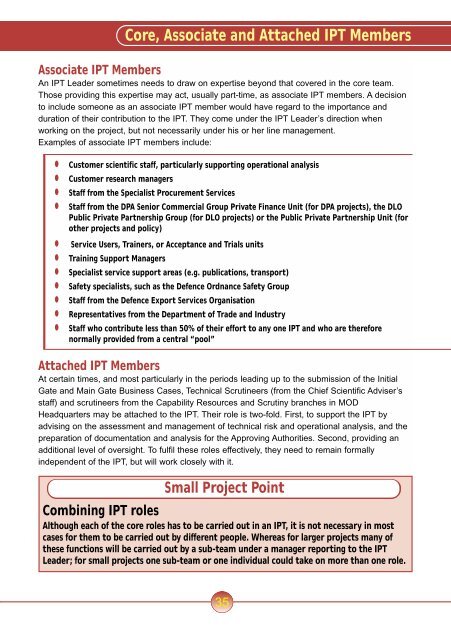The Acquisition Handbook
The Acquisition Handbook
The Acquisition Handbook
- No tags were found...
Create successful ePaper yourself
Turn your PDF publications into a flip-book with our unique Google optimized e-Paper software.
Core, Associate and Attached IPT MembersAssociate IPT MembersAn IPT Leader sometimes needs to draw on expertise beyond that covered in the core team.Those providing this expertise may act, usually part-time, as associate IPT members. A decisionto include someone as an associate IPT member would have regard to the importance andduration of their contribution to the IPT. <strong>The</strong>y come under the IPT Leader’s direction whenworking on the project, but not necessarily under his or her line management.Examples of associate IPT members include:Customer scientific staff, particularly supporting operational analysisCustomer research managersStaff from the Specialist Procurement Services•Staff from the DPA Senior Commercial Group Private Finance Unit (for DPA projects), the DLOPublic Private Partnership Group (for DLO projects) or the Public Private Partnership Unit (forother projects and policy)Service Users, Trainers, or Acceptance and Trials unitsTraining Support ManagersStaff from the Defence Export Services Organisation•Specialist service support areas (e.g. publications, transport)Safety specialists, such as the Defence Ordnance Safety GroupRepresentatives from the Department of Trade and IndustryStaff who contribute less than 50% of their effort to any one IPT and who are thereforenormally provided from a central “pool”Attached IPT MembersAt certain times, and most particularly in the periods leading up to the submission of the InitialGate and Main Gate Business Cases, Technical Scrutineers (from the Chief Scientific Adviser’sstaff) and scrutineers from the Capability Resources and Scrutiny branches in MODHeadquarters may be attached to the IPT. <strong>The</strong>ir role is two-fold. First, to support the IPT byadvising on the assessment and management of technical risk and operational analysis, and thepreparation of documentation and analysis for the Approving Authorities. Second, providing anadditional level of oversight. To fulfil these roles effectively, they need to remain formallyindependent of the IPT, but will work closely with it.Small Project PointCombining IPT rolesAlthough each of the core roles has to be carried out in an IPT, it is not necessary in mostcases for them to be carried out by different people. Whereas for larger projects many ofthese functions will be carried out by a sub-team under a manager reporting to the IPTLeader; for small projects one sub-team or one individual could take on more than one role.35
















